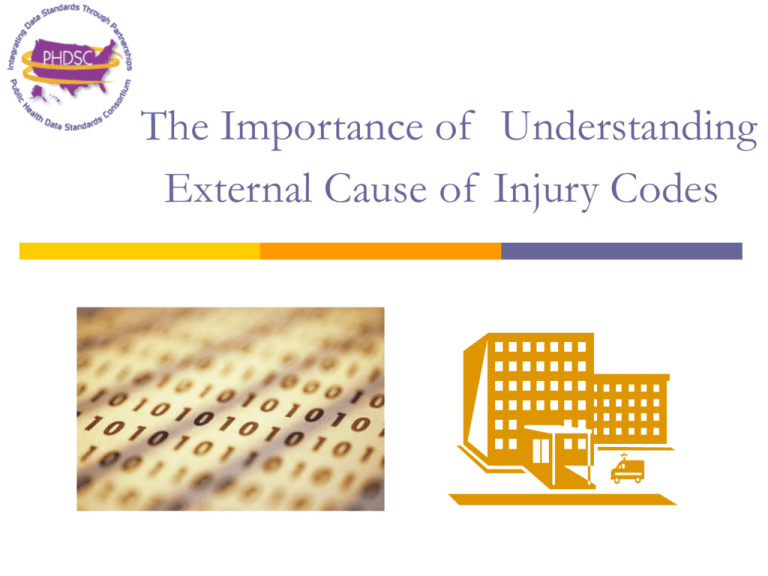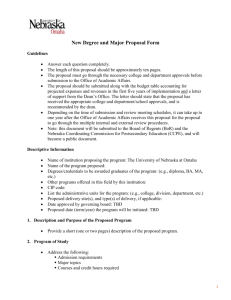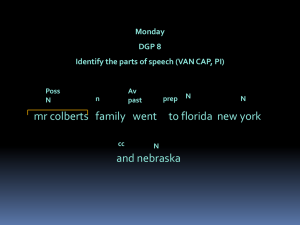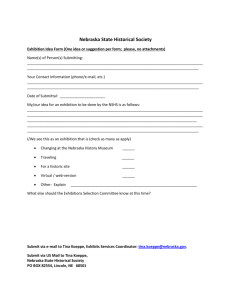Importance of Understanding External Cause of Injury Codes
advertisement

The Importance of Understanding External Cause of Injury Codes This presentation is designed to: Define external cause of injury codes Inform and Educate health care providers, policymakers, and the public health community about current State practice in the collection and use of external cause of injury codes Propose the next steps necessary to improve external cause code reporting What are External Cause of Injury Codes? The International Classification of Diseases (ICD) was designed by the World Health Organization to code and classify morbidity and mortality data. In the United States, the ICD-CM (clinical modification) is used to classify morbidity (nonfatal) events. The ICD-CM is periodically updated; ICD-9-CM (9th Revision) is currently used. New codes can be added annually through the Coordination and Maintenance Committee. When an injury is the result of an external cause (versus an illness or disease) an external cause code is used in addition to the injury code. For more information on ICD-9-CM visit: http://www.cdc.gov/nchs/about/otheract/icd9/abticd9.htm What are External Cause of Injury Codes? External cause of injury codes provide a framework for systematically collecting patient health related information on external cause of death, injury, poisoning and adverse effects. External cause of injury codes define both the manner of the death or injury, the mechanism, and the place of occurrence of the event. Manner: Unintentional/Self-inflicted/ Assault/Undetermined Mechanism: e.g., Fall Place of Occurrence: e.g., Playground Sample External Cause of Injury Codes Category Code Unintentional Injury Motor Vehicle E810 E814 Falls E880 E883 Intentional Injury E950 Self-inflicted E957 Assault E960 E964 Definition -Motor vehicle accident involving collision with train -Motor vehicle accident involving collision with pedestrian -Fall on or from stairs or steps -Fall into hole or other opening in surface -Suicide and other self-inflicted poisoning by solid or liquid substances -Suicide and self-inflicted injury by jumping from high places -Fight, brawl, rape -Assault by submersion (drowning) Why are External Cause of Injury Codes Important? According to the Centers for Disease Control: In 2004, there were an estimated 40.2 million injury-related visits to U.S. emergency departments, representing 35% of all emergency department visits. Injuries due to falls (21%), striking against or being struck accidentally by objects or persons (11%) and motor vehicle trafficrelated injuries (10%) accounted for the largest proportion of injury-related emergency department visits in 2004. SOURCE: National Center for Health Statistics, data from the National Hospital Ambulatory Medical Care Survey- ED component, 2004 Why are External Cause of Injury Codes Important? External cause of injury codes can help us to: Describe the magnitude of injury morbidity by cause of injury. Identify population subgroups at high risk for a particular cause of injury. Identify specific high incidence causes of injuries in certain geographic locations. e.g., bicycle-related injuries in children aged 5-14 years. e.g., scald burns among 3-year-old children living in an inner city area. Identify the place of occurrence for specific types of injuries and for specific population groups. SOURCE: The Council of State and Territorial Epidemiologists. (March 2005). How States are Collecting and Using Cause of Injury Data: 2004 Update to the 1997 Report. Why are External Cause of Injury Codes Important? External cause of injury codes can also help us to: Develop prevention strategies targeting specific causes of injury and specific population groups of communities at risk. e.g., helmet give-away programs and educational campaigns to school-aged children. Evaluate the effectiveness of intervention programs. e.g., the cost-effectiveness of helmet use programs in reducing bicycle-related injuries in children. SOURCE: The Council of State and Territorial Epidemiologists. (March 2005). How States are Collecting and Using Cause of Injury Data: 2004 Update to the 1997 Report. Historical Perspective on External Cause of Injury Codes In 1991, the National Committee on Vital and Health Statistics (NCVHS) recommended that external cause of injury codes be included in the hospital discharge data (HDD) sets. Only 5 states had HDD systems that collected external cause of injury codes. In 1992, a UB-92 (hospital claims form) was approved which included a labeled space for external cause of injury codes. In 1994, 27 states had hospital discharge data systems that were gathering external cause of injury data. Today, only five states lack hospital discharge data systems and more than half of all states require that external cause of injury data be routinely collected. Sources: Report on the Need to Collect External Cause-of-Injury codes in Hospital Discharge Data. 1991 Annual Report of the National Committee on Vital and Health Statistics, Appendix VI, page 86 & The Council of State and Territorial Epidemiologists. (March 2005). How States are Collecting and Using Cause of Injury Data: 2004 Update to the 1997 Report. Statewide Hospital Discharge Data Systems and External Cause of Injury Codes External cause of injury codes mandated and year mandated (26) External cause of injury codes routinely collected, not mandated (16) Source: The Council of State and Territorial Epidemiologists. (March 2005). How States are Collecting and Using Cause of Injury Data: 2004 Update to the 1997 Report. No statewide HDDS (5) Statewide HDDS, external cause of injury codes not routinely collected (3) Statewide Hospital Discharge Data Systems (HDDS) and External Cause of Injury Codes 45 of the 50 states and the District of Columbia currently have a statewide HDDS in place. 42 of the 45 states that have an HDDS routinely collect some level of external cause of injury codes in their HDDS. 26 states and the District of Columbia have mandates that require the routine collection of external cause of injury data in their statewide HDDS. Statewide Hospital Emergency Department Data Systems and External Cause of Injury Codes External Cause of Injury Codes mandated and year mandated (15) External Cause of Injury Codes routinely collected, not mandated (8) Source: The Council of State and Territorial Epidemiologists. (March 2005). How States are Collecting and Using Cause of Injury Data: 2004 Update to the 1997 Report. No statewide HEDDS (25) Statewide HEDDS, external cause of injury codes not routinely collected (2) Statewide Hospital Emergency Department Data Systems (HEDDS) and External Cause of Injury Codes 25 of the 50 states and the District of Columbia have a statewide HEDDS. 23 of these 25 states and the District of Columbia routinely collect some level of external cause of injury codes in their statewide HEDDS. 15 of the 23 states that routinely collect some level of external cause of injury codes have mandated external cause coding of their statewide HEDDS. Case Studies: The following compelling stories demonstrate the application and usefulness of external cause of injury codes. Utah, California, Nebraska and Missouri are collecting, reporting and using external cause of injury data, with the goal of expanding the use of external cause of injury codes. Utah: Violence and Injury Prevention Program Background The Utah Department of Health’s (UDOH) Violence and Injury Prevention Program (VIPP) seeks to reduce the occurrence of fatal and non-fatal injuries among Utah residents. UDOH uses ICD-9-CM external cause of injury codes in conjunction with their associated diagnosis codes to identify adverse medical events and shares this information with all acute care hospitals in the state. Utah: Violence and Injury Prevention Program As a result of the program, UDOH: Developed electronic tools to make reporting of adverse events easier for hospital personnel; Planned and implemented community-based injury prevention programs and activities; and Helped several hospitals improve the quality of care delivered by providing personnel with identifiers for patients presenting to the hospital after adverse events. California: Incorporating External Cause Codes into HDDS Program Overview Virtually 100 percent of California’s hospital discharge data incorporates external cause of injury coding. As a result, the Epidemiology and Prevention for Injury Control (EPIC) Branch of the Department of Health Services has been able to influence legislation and recommend activities to promote the public health. Between 1991-2004, EPIC provided grants to 28 county and 3 city health departments to help them build capacity for violence prevention. California: Incorporating External Cause Codes into HDDS As a result of the program, external cause of injury coded patient data have been used to: Enact legislation to decrease the number of small children that drown (or near-drown) in pools and spas; Create mandates for firearm safety in response to youth accidents and suicides from unauthorized access to guns; Support programs that address preventable injuries associated with bikes, motorcycles, senior falls, and child abuse, among others. Nebraska and Missouri : The Pyramid of Injury Study Overview A recent study conducted by the University of Nebraska Medical Center, the Nebraska Health and Human Services, the Missouri Department of Health and the Department of Emergency Medicine at Emory University reviewed external cause code frequencies for all injuries reported by acute care hospitals (both inpatient and emergency departments) in Missouri and Nebraska from 1996 through 1998. Reporting of external cause of injury is mandatory in these two states. Source: Wardman MC; Mueilman RL; Coto JA; Kellermann AL. The pyramid of injury: using e-codes to accurately describe the burden of injury. Annals of emergency medicine, Oct.2003; Vol.42, No. 4, pp 468-78. Nebraska and Missouri : The Pyramid of Injury Purpose of the Study The authors suggest that viewing injury from the limited perspective of fatal outcomes may lead to disproportionate attention to high case-fatality and low morbidity rate causes of injury (e.g., firearm suicides and homicides). Furthermore, injury causes with relatively low case-fatality rates but high morbidity rates could be underemphasized (e.g., motor vehicle crashes and falls). Source: Wardman MC; Mueilman RL; Coto JA; Kellermann AL. The pyramid of injury: using e-codes to accurately describe the burden of injury. Annals of emergency medicine, Oct.2003; Vol.42, No. 4, pp 468-78. Nebraska and Missouri : The Pyramid of Injury Study Benefits The study demonstrates the feasibility and value of reporting external cause of injury of all injured patients requiring emergency department evaluation and / or hospitalization. The standardized collection and reporting of externalcause-of-injury codes by health care providers (e.g., hospitals) can help to better describe the burden of injury on our society and economy. Low case-fatality rate – high morbidity rate causes of injury have a far greater cumulative effect on health care system use and costs than high case-fatality rate – low morbidity rate causes of injury. Source: Wardman MC; Mueilman RL; Coto JA; Kellermann AL. The pyramid of injury: using e-codes to accurately describe the burden of injury. Annals of emergency medicine, Oct.2003; Vol.42, No. 4, pp 468-78. Nebraska and Missouri : The Pyramid of Injury Examples of using external cause of injury codes for injury prevention initiatives in Nebraska Nebraska Health and Human Services’ Injury Prevention Program established an Injury Prevention Advisory Committee to oversee external cause of injury activities. An Injury Prevention State Plan has been created based on data from the Nebraska Hospital Discharge Database outlining recommendations for reducing the prevalence and severity of injuries in the state. Source: Wardman MC; Mueilman RL; Coto JA; Kellermann AL. The pyramid of injury: using e-codes to accurately describe the burden of injury. Annals of emergency medicine, Oct.2003; Vol.42, No. 4, pp 468-78. Nebraska and Missouri : The Pyramid of Injury Additional examples of using external cause codes for injury prevention initiatives in Nebraska Local health departments are using E-code data for injury prevention purposes. Maternal and Child Health prevention and other programs are using E-codes to establish top injury prevention priorities. External cause of injury code data is linked to other databases (e.g., motor vehicle crashes, death certificates, and ambulance records) to produce information for the National Highway Traffic Safety Administration, Nebraska Highway Safety, Nebraska Injury Prevention Programs and the State Legislature. Source: Wardman MC; Mueilman RL; Coto JA; Kellermann AL. The pyramid of injury: using e-codes to accurately describe the burden of injury. Annals of emergency medicine, Oct.2003; Vol.42, No. 4, pp 468-78. Current Challenges to External Cause Code Collection While the number of states that have incorporated external cause of injury codes into hospital discharge data systems and hospital emergency department data systems is increasing, data collection in terms of both quantity and quality varies across states. Completeness and accuracy of external cause code reporting by hospital personnel are essential, however incomplete information is often provided. Source: The Council of State and Territorial Epidemiologists. (March 2005). How States are Collecting and Using Cause of Injury Data: 2004 Update to the 1997 Report. Current Challenges to External Cause Code Use In some states, hospital discharge data and hospital emergency department data often do not include information about the external causes of nonfatal injuries. There is inconsistent reporting of external causes of injury nationwide, limiting the usefulness of national hospital discharge data for injury surveillance. Source: The Council of State and Territorial Epidemiologists. (March 2005). How States are Collecting and Using Cause of Injury Data: 2004 Update to the 1997 Report. Areas of Future Focus Key stakeholders should work together to promote the development of HDDS and HEDDS, as well as the routine collection of external cause of injury codes in those states lacking these systems. State injury surveillance efforts should be improved to create more uniform tabulation and analysis of external cause of injury data. E.g., CDC’s National Center for Health Statistics (NCHS), National Center for Injury Prevention (NCIPC) and other organizations created a framework for systematically grouping external cause of injury data to standardize the collection, processing, and tabulation of reliable and comparable injury data at the national, state and local level. Source: The Council of State and Territorial Epidemiologists. (March 2005). Update to the 1997 Report. How States are Collecting and Using Cause of Injury Data: 2004 Areas of Future Focus Hospitals should provide training for healthcare information management personnel on external cause of injury codes to improve completeness and accuracy of external cause code reporting. External cause code users should provide feedback to providers regarding the importance of having accurate and complete external cause code information, how the information is being used, and providing suggestions for improvement. Source: The Council of State and Territorial Epidemiologists. (March 2005). Update to the 1997 Report. How States are Collecting and Using Cause of Injury Data: 2004 For More Information Organizations Centers for Disease Control National Center for Health Statistics http://www.cdc.gov/nchs/ National Center for Injury Prevention and Control http://www.cdc.gov/ncipc/ State and Territorial Injury Prevention Directors Association http://www.stipda.org Council of State and Territorial Epidemiologists http://www.cste.org World Health Organization The Centers for Medicare and Medicaid Services http://www.who.int/violence_injury_prevention/en/ http://www.cms.hhs.gov The Public Health Data Standards Consortium http://www.phdatastandards.info For More Information Selected Publications Please visit the following link to view a list of Web resources on external cause of injury codes. http://www.injuryprevention.org/ecic/





